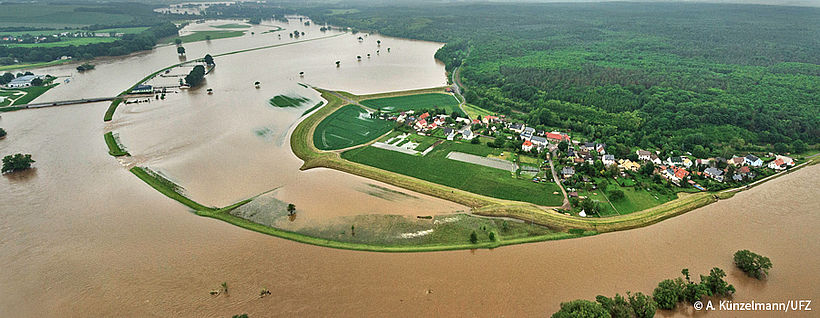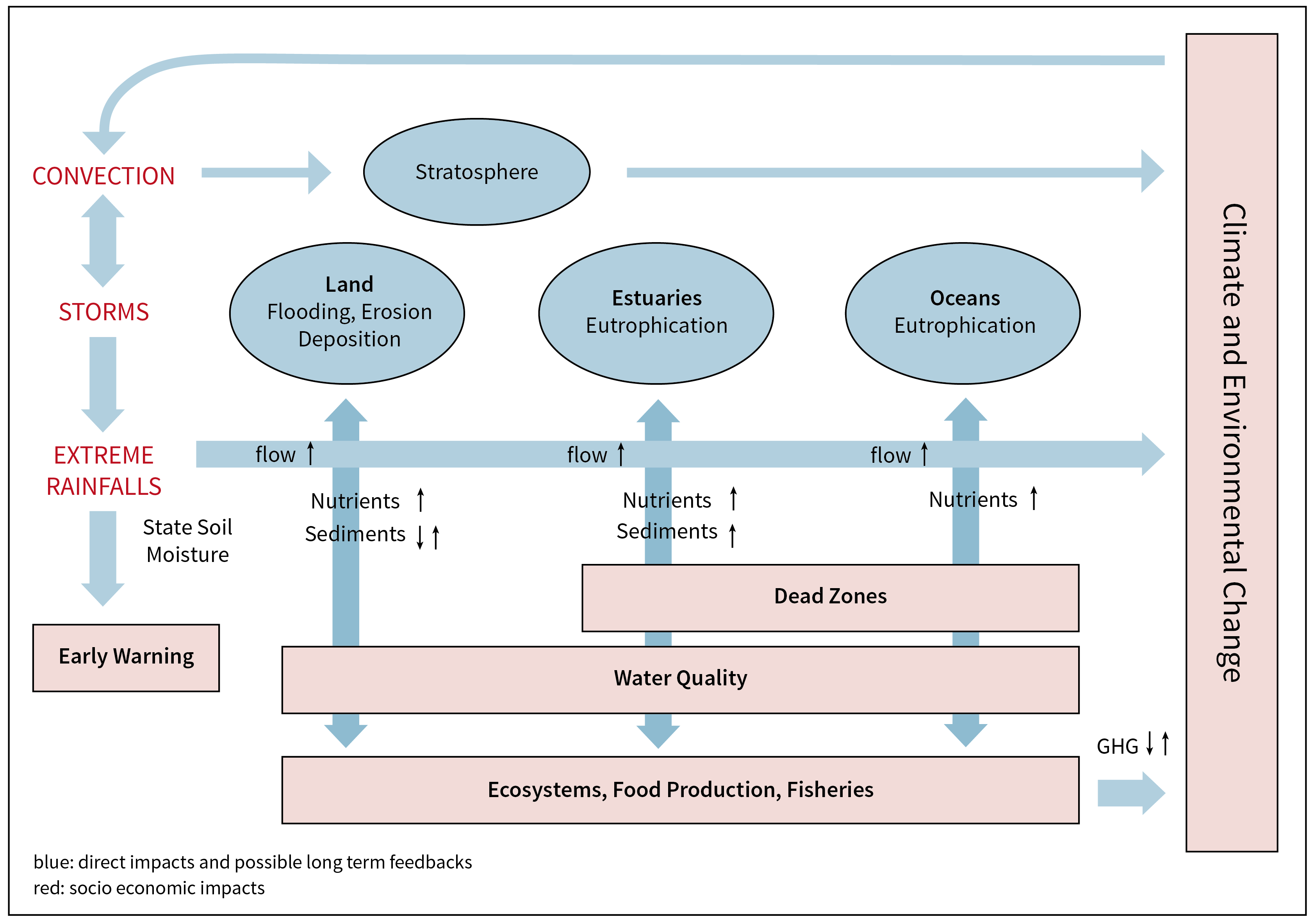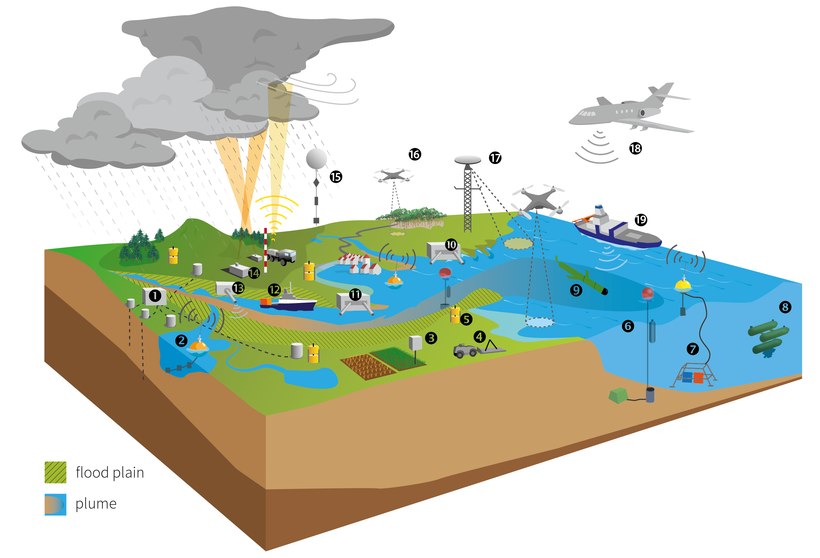
Heavy Precipitation and Floods
In the past 30 years, the frequency of heavy precipitation events increased globally, and projections of river floods indicate increases in the course of the century for most regions. Prominent recent extremes in Central Europe are the floods in the Elbe and Danube catchments in 2002, 2006, 2010 and 2013. In 2021, several European countries were affected by severe floods, most devastating in the German Eifel region. In Germany alone, more than 180 people lost their lives and damages exceeded €33 billon. In addition, a series of localized flash floods on small river catchments were triggered by convective storms in 2016 and 2017. Because of their enormous socioeconomic damages, a thorough understanding of the evolution and impacts of heavy precipitation and flood events is mandatory.
The event chain approach for investigating hydrological extremes aims at a better understanding of the evolution of high precipitation events and their interlinkage with the hydrological system. Three strands of event chains are the focus of MOSES campaigns:
- In the Atmosphere, both persistent frontal rains from slow moving cyclones and intense atmospheric convection can cause heavy precipitation events leading to severe flooding.
- On the land surface, flood risk is enhanced in catchments where heavy precipitation coincides with specific antecedent hydrological conditions, such as saturated soil and/or snowmelt or hydrophobic soils due to preceding droughts.
- Floods affect aquatic systems by a pulse-like mobilization of sediments, contaminants and nutrients, thus threatening the quality status of lakes, rivers and coastal environments.
 Schematic diagram of hydrologic event chains triggered by synoptic scale storms: Synoptic scale storm events cause atmospheric convection and extreme precipitation events. The subsequent flood wave affects the terrestrial systems by land erosion and nutrient and matter mobilization. Water constituents are transported with the flow to lower river areas and the aquifers of the catchment area and finally reach the estuary and coastal waters. The event driven surplus import of matter and nutrient cause eutrophication of the coastal waters and affect the environmental health status and the socio-economic value of the related systems with a high potential for complex feedbacks.
Schematic diagram of hydrologic event chains triggered by synoptic scale storms: Synoptic scale storm events cause atmospheric convection and extreme precipitation events. The subsequent flood wave affects the terrestrial systems by land erosion and nutrient and matter mobilization. Water constituents are transported with the flow to lower river areas and the aquifers of the catchment area and finally reach the estuary and coastal waters. The event driven surplus import of matter and nutrient cause eutrophication of the coastal waters and affect the environmental health status and the socio-economic value of the related systems with a high potential for complex feedbacks.
Highly mobile and interoperable measuring systems are required to monitor the multiple and interconnected processes of the different environmental systems. Such a concerted observation campaign for heavy precipitation and flood events is illustrated in the block diagram.
 MOSES measurement infrastructure for observing hydrologic extremes using the following modules: module biota with (1) Functional microbiome changes measured by online metagenomics and metabolomics, (11) Mobile mesocosms, (12) Stream research vessel; module flow and sediment dynamics with (2) Buoy with multi-parameter sensors, (6) Vertical profilers for coastal and limnic sensors, (7) Underwater nodes with surface buoys, (13) River flow and sediment monitoring system; module water balance with (3) Soil moisture determination using mobile Cosmic Ray sensors, (4) Mobile hydrogeophysics to determine subsurface soil properties, (5) Gravimeter unit for water storage monitoring; module autonomous vehicles with (8) Swarm of underwater-robots, (9) Ocean gliders; module coastal and marine mobile systems with (10) Container with lab equipment, (18) Airborne IR and hyperspectral cameras, (19) Coastal research vessel; module atmospheric dynamics with (14) Lidar, X-Band-Radar, wind with KITcube, (15) Ballon sondes for water vapour, ice particles and tracer; module soil and water quality with (16) UAV for monitoring water quality and vegetation; module fixed point observatories with (17) VHF-Radar system.
MOSES measurement infrastructure for observing hydrologic extremes using the following modules: module biota with (1) Functional microbiome changes measured by online metagenomics and metabolomics, (11) Mobile mesocosms, (12) Stream research vessel; module flow and sediment dynamics with (2) Buoy with multi-parameter sensors, (6) Vertical profilers for coastal and limnic sensors, (7) Underwater nodes with surface buoys, (13) River flow and sediment monitoring system; module water balance with (3) Soil moisture determination using mobile Cosmic Ray sensors, (4) Mobile hydrogeophysics to determine subsurface soil properties, (5) Gravimeter unit for water storage monitoring; module autonomous vehicles with (8) Swarm of underwater-robots, (9) Ocean gliders; module coastal and marine mobile systems with (10) Container with lab equipment, (18) Airborne IR and hyperspectral cameras, (19) Coastal research vessel; module atmospheric dynamics with (14) Lidar, X-Band-Radar, wind with KITcube, (15) Ballon sondes for water vapour, ice particles and tracer; module soil and water quality with (16) UAV for monitoring water quality and vegetation; module fixed point observatories with (17) VHF-Radar system.
The heavy precipitation and floods campaigns started in 2019 as part of the implementation period. They were conducted in the Müglitz Valley and in the Neckar Valley/Swabian Jura, both of which are German hotspot regions for convective storms, heavy precipitation events, and flash floods. From 2022 onwards, the campaigns are carried out as part of the MOSES operating phase.
Evolution and Impacts of Meteorological Extremes
Prof. Peter Knippertz, KIT | peter.knippertz@kit.edu
Dr. Andreas Wieser, KIT | andreas.wieser@kit.edu
Evolution and Impacts of Floods and Low Flows in Aquatic Systems
Prof. Dietrich Borchardt, UFZ | dietrich.borchardt@ufz.de
Dr. Norbert Kamjunke, UFZ | norbert.kamjunke@ufz.de
Prof. Philipp Fischer, AWI | philipp.fischer@awi.de

